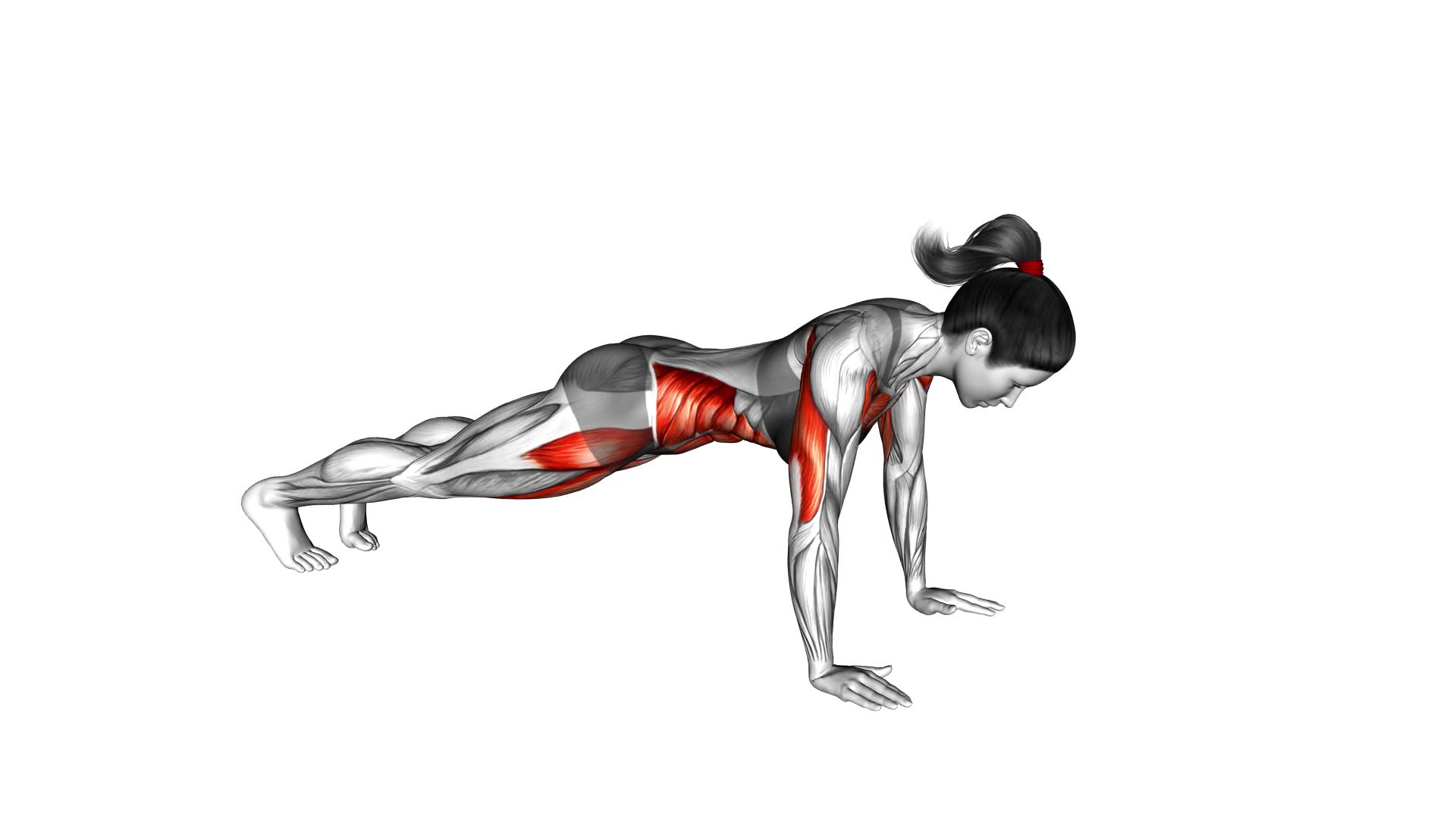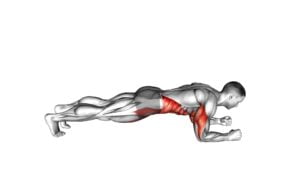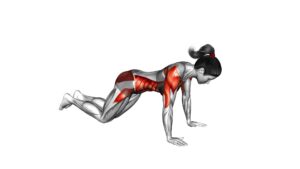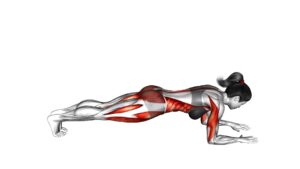Elbow-Up and Down Dynamic Plank (female) – Video Exercise Guide & Tips

Get ready to strengthen your core and challenge your muscles with the Elbow-Up and Down Dynamic Plank.
Watch This Exercise Video
In this video exercise guide, we'll show you how to properly perform this exercise and provide tips for increasing its intensity.
Whether you're a beginner or have limited mobility, we've got modifications for you.
Avoid common mistakes and incorporate this dynamic plank into your workout routine for incredible results.
Let's get started!
Key Takeaways
- The Elbow-Up and Down Dynamic Plank increases core strength and stability.
- It targets abdominal muscles and improves overall core strength.
- Engages multiple muscle groups simultaneously, including abs, back, shoulders, and glutes.
- Proper form and technique are crucial to prevent strain or injury and to get the most out of the exercise.
Benefits of the Elbow-Up and Down Dynamic Plank
You will experience increased core strength and stability with the Elbow-Up and Down Dynamic Plank. This exercise is highly effective in targeting your abdominal muscles and improving overall core strength. One of the main benefits of the Elbow-Up and Down Dynamic Plank is that it engages multiple muscle groups simultaneously, including your abs, back, shoulders, and glutes. By performing this exercise regularly, you can improve your posture and balance, as well as enhance your overall athletic performance.
Another advantage of the Elbow-Up and Down Dynamic Plank is its versatility. There are several variations you can incorporate to make the exercise more challenging or to target specific muscle groups. For example, you can try lifting one leg while holding the plank position to engage your glutes and hamstrings. Additionally, you can add a side plank rotation to work your obliques and improve core stability. These variations allow you to customize your workout and continually challenge your body.
Now that you know the benefits and variations of the Elbow-Up and Down Dynamic Plank, let's move on to discussing the proper form and technique for this exercise.
Proper Form and Technique for the Exercise
To ensure proper execution of the Elbow-Up and Down Dynamic Plank, focus on maintaining a strong and stable core throughout the exercise. This will help you engage the right muscles and prevent any unnecessary strain or injury. Here are some important tips to keep in mind:
- Start in a plank position with your forearms resting on the ground and your elbows directly under your shoulders.
- Keep your body in a straight line from your head to your toes, engaging your core muscles to maintain stability.
- Slowly lift one elbow off the ground and place your hand on the mat, followed by the other elbow, coming into a high plank position.
- Reverse the movement by lowering one hand down to your forearm, followed by the other hand, returning to the starting position.
Common mistakes to avoid include sagging your hips, lifting your hips too high, or allowing your shoulders to round. These can compromise the effectiveness of the exercise and put unnecessary strain on your body.
If you're a beginner, you can modify the exercise by performing it on your knees instead of your toes. This will reduce the amount of weight you have to bear and make it easier to maintain proper form. As you build strength and confidence, you can gradually progress to the full plank position.
Remember to listen to your body and stop if you experience any pain or discomfort. Proper form and technique are key to getting the most out of the Elbow-Up and Down Dynamic Plank while minimizing the risk of injury.
Tips for Increasing the Intensity of the Plank
To increase the intensity of your plank, there are several effective strategies you can try.
One option is to add resistance bands to your plank routine, which will engage your muscles even more.
Another way to challenge yourself is by elevating your feet or hands on a stable surface, such as a step or a yoga block.
Adding Resistance Bands
Increase the intensity of the elbow-up and down dynamic plank by incorporating resistance bands. Here are some tips for adding resistance bands to your plank workout:
- Attach the resistance band around your wrists or forearms to create resistance as you move through the plank exercise.
- The resistance bands can be adjusted to different tensions, allowing you to gradually increase the challenge as you get stronger.
To further intensify the plank, you can also incorporate variations with a stability ball. Try placing your feet on the stability ball while performing the elbow-up and down dynamic plank to engage your core muscles even more.
Elevating Feet or Hands
You can elevate your feet or hands to increase the intensity of the plank.
Elevating your feet during a plank exercise shifts more of your body weight onto your upper body, engaging your core and upper body muscles even more. This can be achieved by placing your feet on an elevated surface like a bench or step.
Elevating your hands during a plank, also known as elevated push-ups, challenges your upper body strength further. By placing your hands on an elevated surface, such as push-up bars or dumbbells, you increase the range of motion and engage your chest, shoulders, and triceps more intensely.
Remember to maintain proper form and alignment throughout the exercise to avoid strain or injury.
Incorporating Side Planks
By incorporating side planks, you can further intensify the plank exercise and target your obliques and lateral core muscles. Side planks are a great way to challenge your stability and engage the muscles on the side of your body.
Here are some side plank variations to try:
- Side plank with leg lift: Lift one leg while holding the side plank position to increase the difficulty and engage your glutes.
- Side plank with rotation: Start in a side plank position and rotate your torso towards the floor, reaching your arm underneath your body. This will engage your obliques even more.
- Side plank with hip dips: Lower your hip towards the floor and then lift it back up, feeling the burn in your obliques.
Incorporating these advanced plank exercises won't only increase the intensity of your workout but also help you develop a strong and toned core.
Modifications for Beginners or Those With Limited Mobility
Modifications for beginners or those with limited mobility can be made to the Elbow-Up and Down Dynamic Plank exercise. If you're new to this exercise or have limited mobility, there are a few adjustments you can make to make it more accessible for you.
Firstly, you can start by performing the plank on your knees instead of your toes. This will reduce the amount of weight on your arms and core, making it easier to hold the position. As you build strength and confidence, you can gradually progress to performing the exercise on your toes.
Another modification you can make is to use an elevated surface, such as a bench or step, to support your upper body. This will decrease the amount of weight you need to lift, making it more manageable for beginners or those with limited mobility.
Additionally, you can also try performing the exercise with your hands placed on a stability ball or using a TRX suspension system. These modifications will provide more support and stability, allowing you to focus on engaging your core muscles.
By making these modifications, you can still reap the benefits of the Elbow-Up and Down Dynamic Plank exercise, even if you're a beginner or have limited mobility.
Now let's move on to the next section and discuss some common mistakes to avoid when performing this exercise.
Common Mistakes to Avoid When Performing the Exercise
To maximize the effectiveness of the Elbow-Up and Down Dynamic Plank exercise, it's important to be mindful of common mistakes to avoid. Here are some common mistakes and variations to watch out for:
- Dropping the hips too low: One common mistake is allowing the hips to sag towards the ground. This not only reduces the effectiveness of the exercise but also puts unnecessary strain on the lower back. Keep your core engaged and your body in a straight line from head to toe.
- Raising the hips too high: On the other end of the spectrum, lifting the hips too high can also compromise the effectiveness of the exercise. It shifts the focus away from the core and places more strain on the shoulders. Aim to maintain a neutral position throughout the movement.
- Using momentum: Another mistake to avoid is relying on momentum to perform the exercise. This can happen when you rush through the movement or use jerky motions. Instead, focus on controlled and deliberate movements, engaging your core muscles throughout.
Incorporating the Elbow-Up and Down Dynamic Plank Into Your Workout Routine
To incorporate the Elbow-Up and Down Dynamic Plank into your workout routine, you can start by gradually increasing the duration and intensity of the exercise. This will allow your body to adjust and build strength over time.
Dynamic planks offer numerous benefits, including improved core stability, increased upper body strength, and enhanced balance. By incorporating this exercise into your routine, you can target multiple muscle groups simultaneously, making your workouts more efficient.
To add variation to your dynamic plank routine, you can try different arm movements. For example, you can lift one arm off the ground while maintaining a stable plank position with the other arm. This variation challenges your core and upper body muscles even further.
Another option is to incorporate leg movements, such as lifting one leg off the ground or performing alternating leg lifts. These variations engage your glutes and lower body muscles, providing a full-body workout.
Incorporating the Elbow-Up and Down Dynamic Plank into your routine not only adds variety but also helps prevent workout plateaus. It challenges your muscles in new ways, promoting continuous progress and improvement.
Remember to listen to your body and gradually increase the intensity as you become stronger and more comfortable with the exercise. With consistency and proper form, you'll reap the benefits of dynamic planks and achieve your fitness goals.
Frequently Asked Questions
How Long Should I Hold the Elbow-Up and Down Dynamic Plank?
To progress in the elbow-up and down dynamic plank, start by holding the position for a few seconds and gradually increase the duration as you build strength.
Incorporating this exercise into your workout routine offers several benefits, such as strengthening your core, shoulders, and arms, improving stability, and enhancing overall body control.
It's an effective way to challenge yourself and improve your overall fitness level.
Can I Do This Exercise Every Day?
Yes, you can do this exercise every day if you'd like.
However, it's important to listen to your body and give yourself rest days when needed.
As for how often you should do the elbow-up and down dynamic plank, it's recommended to start with 2-3 times per week and gradually increase as your strength improves.
Remember to maintain proper form and consult with a fitness professional if you have any concerns.
Are There Any Variations of the Elbow-Up and Down Dynamic Plank?
There are several variations of the elbow-up and down dynamic plank that you can try. These variations include adding leg lifts, performing the plank on an unstable surface like a stability ball, or incorporating side plank rotations.
These variations not only challenge your core muscles in different ways, but also help to improve overall core strength and stability.
Should I Warm up Before Doing This Exercise?
Before diving into the Elbow-Up and Down Dynamic Plank, it's important to warm up your body. Warming up helps increase blood flow, flexibility, and reduces the risk of injury.
You can benefit from performing alternative warm-up exercises like jogging, jumping jacks, or arm circles. These exercises will prepare your muscles and joints for the dynamic plank.
Can I Do This Exercise if I Have a Wrist Injury?
If you have a wrist injury, it's important to modify your exercises to protect your wrists. There are modifications available for wrist-friendly exercises that can help you avoid aggravating your injury.
As for the elbow-up and down dynamic plank, it may not be suitable for you at the moment. Instead, consider trying alternative exercises that don't put as much pressure on your wrists.
Always consult with a professional or physical therapist for personalized guidance.
Conclusion
Incorporating the elbow-up and down dynamic plank into your workout routine can provide numerous benefits for your core strength and stability. By maintaining proper form and technique, you can increase the intensity of the exercise and challenge your muscles even more.
Beginners or individuals with limited mobility can make modifications to suit their needs. However, it's important to avoid common mistakes to prevent injury.
Overall, adding this plank variation to your routine can help you achieve a stronger and more toned core.

Author
Years ago, the spark of my life’s passion ignited in my mind the moment I stepped into the local gym for the first time. The inaugural bead of perspiration, the initial endeavor, the very first surge of endorphins, and a sense of pride that washed over me post-workout marked the beginning of my deep-seated interest in strength sports, fitness, and sports nutrition. This very curiosity blossomed rapidly into a profound fascination, propelling me to earn a Master’s degree in Physical Education from the Academy of Physical Education in Krakow, followed by a Sports Manager diploma from the Jagiellonian University. My journey of growth led me to gain more specialized qualifications, such as being a certified personal trainer with a focus on sports dietetics, a lifeguard, and an instructor for wellness and corrective gymnastics. Theoretical knowledge paired seamlessly with practical experience, reinforcing my belief that the transformation of individuals under my guidance was also a reflection of my personal growth. This belief holds true even today. Each day, I strive to push the boundaries and explore new realms. These realms gently elevate me to greater heights. The unique combination of passion for my field and the continuous quest for growth fuels my drive to break new ground.







